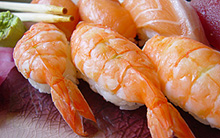 With a history of at least 1,000 years, sushi has now spread across the
world to become the best known type of Japanese food, representing a distinctive
culinary culture integrating tradition and modernity. It became readily
accessible to consumers in Shanghai -- and even more widely popular than before
-- after the advent of conveyor belt sushi outlets in the city. But despite the
dozens of Japanese eateries recently opened in the local market, restaurants
exclusively featuring first-rate sushi are still quite rare at present.
With a history of at least 1,000 years, sushi has now spread across the
world to become the best known type of Japanese food, representing a distinctive
culinary culture integrating tradition and modernity. It became readily
accessible to consumers in Shanghai -- and even more widely popular than before
-- after the advent of conveyor belt sushi outlets in the city. But despite the
dozens of Japanese eateries recently opened in the local market, restaurants
exclusively featuring first-rate sushi are still quite rare at present.
The Pudong Shangri-La's Nadaman sushi bar considers itself one of these few.
The bar is located on the ground floor of the Shangri-La's new tower, decorated
in a simply exquisite style, with a very high ceiling. A long bar table where
two chefs make the sushi runs parallel to a row of dining tables and sofas in
the dining hall. The room is not especially big -- with the capacity to host 35
diners at most.
However, the confined space combines with the bright wooden furniture to
create a cozy ambience. During my most recent visit to the bar, I enjoyed both
the sunshine pouring through the huge glass window and the beautifully presented
Japanese delicacies on offer.
I chose a lunch set called "Fuji" (160 yuan, US$20), consisting of an
appetizer, steamed egg curd, hot udon noodles and assorted sushi -- including
Norimaki and Nigiri. Norimaki is sushi rice, seafood and vegetables rolled in
dried seaweed sheets and Nigiri refers to oval shaped sushi topped with raw
fish.
 Nigiri is commonly regarded as the most representative type of Japanese
sushi as it is a good combination of rice and fish. During the dinner, I sampled
several different kinds of Nigiri, topped with salmon, tuna, salmon roe and
other kinds of fillets, all with a very fresh taste. When you chew these
delicacies, the tender fish and the vinegared rice mix well enough to engender
an amazing flavour which immediately delights all your taste buds.
Nigiri is commonly regarded as the most representative type of Japanese
sushi as it is a good combination of rice and fish. During the dinner, I sampled
several different kinds of Nigiri, topped with salmon, tuna, salmon roe and
other kinds of fillets, all with a very fresh taste. When you chew these
delicacies, the tender fish and the vinegared rice mix well enough to engender
an amazing flavour which immediately delights all your taste buds.
According to Koji Hayashi, chief sushi chef at the sushi bar, what
distinguishes first rate sushi from more common varieties is -- first of all --
the freshness of the fish and then communication between chefs and diners.
"At a conveyor belt sushi outlet, chefs are usually busy making sushi and
have no time to talk with diners. But the situation is different in a refined
sushi bar," he said.
Good sushi also requires properly cooked rice. Koji said the rice used for
making sushi should not be too sticky. "Rolling and folding" the rice also
requires special techniques and skills.
"The chef should finish making a sushi in few seconds to ensure its
freshness. During the preparation, they should leave a small hollow in the
centre of the rice roll, to make it a bit softer to eat," he said.
Another dish worth recommendation is the steamed egg curd, which included
gingko nuts, eel fillets and mushroom inside. In addition, the steamed egg was
topped with a kind of ginger sauce that tasted especially delicious and
appetizing, giving the dish its distinctiveness.
Nadaman sushi bar
Location: 1F, Shangri-La Hotel, No.33, Fuchenglu,
Pudong
Tel: 021-68828888